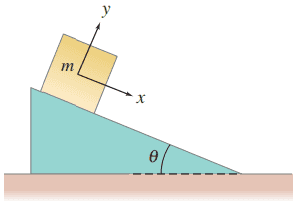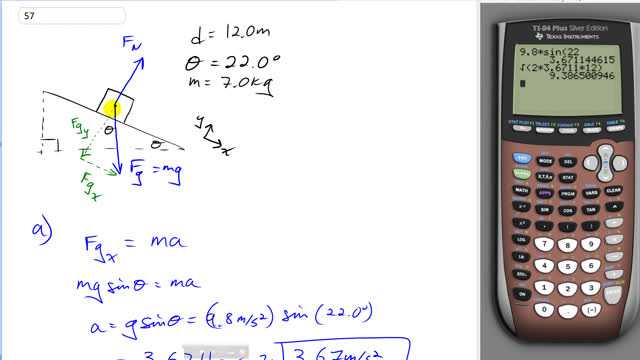
The block shown in Fig. 4–59 has mass and lies on a fixed smooth frictionless plane tilted at an angle to the horizontal.
- Determine the acceleration of the block as it slides down the plane.
- If the block starts from rest 12.0 m up the plane from its base, what will be the block’s speed when it reaches the bottom of the incline?


In order to watch this solution you need to have a subscription.
This is Giancoli Answers with Mr. Dychko. Since there's no friction on this incline, there's only two forces in the free body diagram. There's gravity straight down and which has components perpendicular to the ramp and along the ramp. And then has this normal force, but the normal force we're not actually going to use in a calculation today because there's no friction force. And so, we have to find the acceleration down the ramp and to do that we'll need to know what this x component of gravity is. So, we have our x axis tilted, so, it's directed positive down the ramp. So, we've Fgx is the total net force in the x direction and which makes it equal to ma. And being the opposite leg of this gravity triangle, that means we use sine theta to calculate it multiplying by force of gravity which is mg. So, we have mg sine theta in place of Fgx, and that's equal to ma. And then we'll divide both sides by m so that it cancels. And we have a equals g sine theta, and that is 9.8 meters per second squared times sine of 22 degrees which gives an acceleration of 3.67 meters per second squared down the ramp. The final speed after traveling 12 meters will be found using this kinematics formula. So, we have final speed squared equals initial velocity squared plus 2ad. And the initial velocity is zero. And then take the square root of both sides and we end up with final velocity is square root 2 times acceleration times displacement. So, that's square root of 2 times 3.6711 meters per second squared times 12 meters which gives 9.39 meters per second at the bottom of the ramp
How do you know the angle theta used to resolve the components is the same as the angle the incline makes with the horizontal? Please refresh my geometry!
I found a good explanation online so I'm all set!